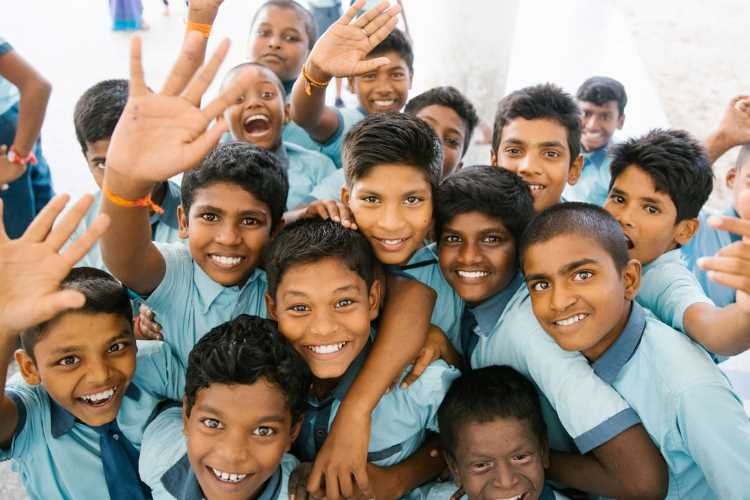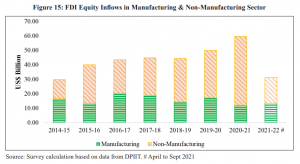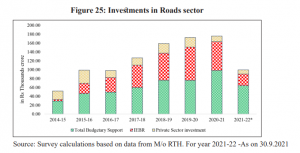
In her Budget 2022 speech on February 1, finance minister Nirmala Sitharaman said that the budget proposals seek to give a blueprint for steering the economy over the next 25 years – from India at 75 to India at 100. She expressed hope that the PM Gati Shakti National Master Plan encompassing the seven engines — roads, railways, airports, ports, mass transport, waterways, and logistics infrastructure — will lead to huge employment and entrepreneurial opportunities. In line with the strategy, the most highlighted provision in the Budget is the higher allocation to capital expenditure, which has been enhanced by 35.4% in 2022-23 to 2.9% of the GDP.
The push for infrastructure creation in a big way is a major focus area of the blueprint for economic growth for the next 25 years. Some of the projects listed in the budget are:
- The creation of a unified logistics interface platform (ULIP) to provide efficient movement of goods through different modes, reducing logistics cost and time.
- Awarding of contracts for the setting up of multimodal logistics parks at four locations through PPP mode in 2022-23.
- Spectrum auctions in 2022 to facilitate the rollout of 5G mobile services.
- Replacing the Special Economic Zones Act with new legislation that will enable states to become partners in the development of enterprise and service hubs.
- Development and manufacture of 400 new-generation Vande Bharat Trains during the next three years.
- A digital university to provide students access to world-class universal education across the country.
- Allocation of Rs 60,000 crore to cover 3.8 crore households under Har Ghar, Nal Se Jal in 2022-23.
- Allocation of Rs. 48,000 crores for 80 lakh houses to be completed for the identified eligible beneficiaries of PM Awas Yojana.
- Creation of a professionally-managed development financial institution for financing infrastructure projects and allocation of a sum of Rs 20,000 crore to capitalise this institution.
READ I Easing of public debt burden will cause economic disruption
The commitments made in the budget for the development of infrastructure, accelerating growth in the manufacturing sector, and achieving an export target of $1 trillion by 2030 aim to address the following areas:
- Improving connectivity and logistics efficiency.
- Achieving climate change targets from commitments in COP26 with initiatives around clean mobility.
- Enhancing the ease of doing business in India.
- Promoting self-reliance and local manufacturing.
Budget 2022 on the nation’s priorities
Budget 2022 has been welcomed by business and industry and the stock market responded favourably. Government officials described the budget as one that focuses on the growth-boosting demand side of the economy to kick-start an investment cycle for sustained growth in the next 25 years.
While the development of infrastructure and logistics are to be lauded, questions have been raised since resources are scarce and some areas of critical importance for the national economy have not received due allocation. Has India set its priorities right, considering the challenges being posed by the pandemic and the impact of economic slowdown? How accurate and detailed are the blueprints in terms of human and material resources management to ensure that both time and resources do not get wasted?
READ I Timely action on inflation needed to avert hard landing, says Maurice Obstfeld
Policymakers are relying heavily on capital expenditure with the hope that it will spur private as well as foreign investment. A higher capital expenditure allocation is a trend in the government’s spending in the budgets presented in the last 3-4 years which is good for the economy. What has surprised most is a 25.51% cut in the allocation for the rural jobs guarantee program MGNREGA as the scheme is meant to ensure the livelihood security of rural households. Moreover, the cut in the MGNREGA allocation does not appear to be in line with the government’s declaration that an all-inclusive welfare focus is its vision for the next 25 years.


It is to be understood that MGNREGA is not just a wage-employment programme, but also has the potential to create useful infrastructure to address the issues of connectivity in rural areas to boost economic activity. Many documents brought out by state governments have acknowledged that MGNREGA has succeeded to an extent in creating productive and sustainable assets over a period.
It thus raises questions like whether huge public capital expenditures as proposed divert resources from other equally vital productive areas like R&D, modernisation or upgradation of human resources, skill development, investment in labour-intensive sectors, and welfare measures needed for immediate relief for those affected by the Covid-19 pandemic.
Let us examine the criticality of some areas considered vital for planning and sustaining the long-term growth of an economy.
Human resources development
Human development, human capital, and the economic growth of a nation are closely correlated and therefore any strategy for medium and long-term growth cannot underestimate the importance of human resources development. The basic education level of labour plays a dominant role in determining the skills acquired by them and their impact on productivity. Budget 2022 has proposed an allocation of Rs 1,04,277 crore on education (around 2.6 % of the GDP). Of this, Rs 40,828 crore will go for higher education.
The current budget spending on education continues to be low, far from the 6% of GDP recommended by NEP 2020 and insufficient for bridging the literacy gap in the short term. What India needs is more teachers, better educational infrastructure and better classroom attendance to upgrade school education as people in rural areas cannot access TV channel-driven education or online education through digital media.
The ambitious target of the government to provide high-speed broadband connectivity to all gram panchayats, which would help facilitate equitable access to broadband services across the country. However, it must be accepted that (i) as of now, there exists a digital divide in the country and the lack of digital infrastructure is not the only cause responsible for it, and (ii) digital education alone cannot be a complete substitute for physical classrooms because of its one-way communication approach.
The lack of access to quality education and skill development training has kept marginalised sections in a vicious circle of low skills, low-productivity employment and low income. Around 70% of the labour force residing in rural areas faces underemployment for lack of skills. The huge percentage of rural youth fit for only unskilled jobs calls for a need to strengthen the basic education system in rural areas and align it to right training and skills to enhance their employability and self-employability.
The Pradhan Mantri Kaushal Vikas Yojana (PMKVY) and the Deen Dayal Upadhyay Gramin Kaushal Yojana (DDU-GKY) so far had limited success, thus requires strengthening. The budget announced the launch of a new portal DESH-stack e-portal to empower citizens to skill, reskill, or upskill through online training. Though a catching idea, it raises the question of the effectiveness of online training or education when evaluated with the skill requirements for shop floor jobs. The training syllabus while developing qualified computer-savvy workers to navigate through complex global supply chains should also take into consideration language and cultural issues associated with rural youths.
Nurturing innovation culture
The role of innovation as a critical driver of long-term transformational growth is well established. It is central to addressing the challenges we face, ranging from local challenges like low productivity to global challenges emanating from climate change and pandemics. Going by the monumental mistakes in semiconductor development and production, India may lose the opportunity to establish its position as a global leader in science, technology, and manufacturing.
The periods of high economic growth in the global economy since the 18th century occurred due to the discovery of new technology, innovative products, or new resources (either material or energy). Very recently, with the advent of the internet and digitisation, the world has witnessed the emergence of new-age sectors pushing growth, creating fresh entrepreneurship and employment opportunities. In the UK, which ranks 4th in the Global Innovation Index (GII) rankings, education spending is the second-largest component of public service spending, only behind health. The country has spent an excess of 5% of its GDP on education consistently for many years.
The comparison with UK is relevant as the two countries have similarly sized economies in terms of GDP. Now look at our budget statistics. The budget 2022 has a total allocation of Rs 14,217 crore to the ministry of science and technology, a 3.9% decrease from the last fiscal year. The total amount allocated to the science and technology sector accounts for only 0.3% of the total budget outlay which is Rs 39,44,908 crore. The scientific community is disappointed with the paltry sum allocated.
The New Education Policy (NEP 2020) announced in July 2020 emphasised knowledge creation and research as the fundamental principles critical for sustaining a large and vibrant economy. It proposed establishing a National Research Foundation (NRF) with the objective of funding competitive, peer-reviewed grant proposals of all types and across disciplines. In Budget 2021, the government set aside Rs 50,000 crore for the NRF over five years.
Surprisingly, the current budget did not mention the NRF. One of the ideas behind setting up the NRF was to make research funding less bureaucratic. It was supposed to be governed independently by a board consisting of the very best researchers and innovators across fields. The concept of NRF is in line with global practices and could be entrusted with the task of developing independent technology and innovation centres for specific fields in partnership with industry to undertake R&D and commercialise academic research based on the Catapult model of the UK and to bridge the gap between universities and businesses.
There is another barrier coming in the way of research and innovation which is the mindset. In general, public policymakers are found to be prone to reluctance towards the benefits of innovation as they take time to materialise. Often companies too are unenthusiastic or tend to avoid investments in R&D as the expected returns are uncertain or take time to deliver.
The answer lies in the government stepping in with policy instruments like fiscal support for R&D and favourable tariffs to promote innovation. In the Indian context, it is considered more critical since key sectors in India like the auto, chemical, and pharmaceutical industries are considered highly R&D intensive. Some steps listed below would help address the issues:
- The government should target spending 3% of the GDP on R&D by 2027 to support research and innovation.
- Partnerships between academia and industry should be promoted through the mechanism established via NRF. This will help researchers who have been looking for commercial partners.
- Access to capital is a big concern for smaller companies to grow with in-house developed innovative technology compelling them to look for overseas venture capital funds or sell their intellectual property to foreign companies which means an opportunity lost to create wealth in India and job gains.
- Incentives such as tax rebates should be given as a means of encouraging additional private investment since there seems to be an imbalance between public and private investment in R&D. India’s private sector, unlike that of Japan, China or the US, contributes less than 40% of the total R&D spending.
The innovation policy should not limit itself to fiscal incentives for R&D activities only. It also needs to address the issue more comprehensively in related policy domains like education, science and technology, investment, and financing an institutional structure for interaction between stakeholders like universities, research institutes, industry, banks, venture capitals, and government agencies under the framework of a broader innovation policy.
The proposed setting up of an expert committee, as announced in the budget, to examine and suggest appropriate measures to scale up Venture Capital and Private Equity investment is a good step forward as the issue requires a holistic examination of regulatory and other barriers. An early report and faster implementation of the recommendations will help in materializing new ideas into products and services.
Manufacturing sector has enormous potential
According to a report by McKinsey and Company, the manufacturing sector has the potential to generate $1.25 trillion of GDP in 2030, more than double the $500 billion it accounted for in 2020. For the manufacturing sector, which plays a key role in the economic growth of a developing economy, Budget 2022 proposes extending a concessional tax regime of 15% for newly incorporated domestic manufacturing companies by one year till March 31 2024 which is a welcome move.
Another proposal to phase out the concessional import duty rates gradually in capital goods under project imports and apply a higher tariff of 7.5% appears out of sync with the policy to promote the manufacturing sector. While the proposal to remove concessional duty under project imports is intended to support domestic manufacturers of capital goods, it will lead to an enhanced capital cost for such new production units which prefer to procure their production machines from imported sources.
Keeping in view the current high rate of WPI pushing up the cost of inputs, it is considered desirable to continue with the project import concessions to encourage investment in domestic manufacturing by supplementing incentives being offered under the PLI scheme.
Reducing the cost of doing business
The budget speech by Nirmala Sitharaman mentioned the over 25,000 compliances reduced and 1486 Union laws repealed as part of the government’s efforts to improve the ease of doing business. Although the EoDB rankings of countries by the World Bank has been stopped for lack of credibility due to some reports of irregularities in the process, the government is continuing to rank states by a process developed in consultations with the World Bank by reviewing and verifying the reports submitted by the states.
The ranking of states under BARP is a reform process and must continue despite the questions raised about the transparency of the process. A lot, however, needs to be done at the district level as entrepreneurs feel that the reforms are yet to influence the mindset of ground-level functionaries. Removing any avoidable delay in the administrative process not only means fewer irritants but also helps in keeping the costs of the final product lower, thereby enhancing competitiveness in the market.
The issue of the cost of doing business in India needs to be comprehensively scrutinized to address issues like land acquisition costs, stamp duty, costs of procuring licenses and approvals, production costs, transportation of goods and products, etc as altogether these factors push the final cost of the product, nullifying the low labour cost and other demographic advantages which India still enjoys.
Routing capital to productive sectors
A long-term strategy for economic growth has to be based on a diligent analysis of the country’s circumstances and its resources as well as an assessment of the constraints on growth, emerging opportunities, and a fair understanding of different risks involved. Based on the above, expenditure on physical and social infrastructure and other growth-oriented programmes and activities should be prioritised. Accordingly, the policymakers need to identify the actions that have the highest impact on job creation and inclusive growth.
In the Indian context, besides transportation and communication infrastructure, the basic school education infrastructure is also critical and should be designed to maximise its accessibility and effectiveness to improve the employability of the youth in rural and semi-urban areas.
For a country of India’s size and aspirations, higher education is no less critical as it empowers the youth to engage in critical thinking and look for technological solutions to social and economic problems. Thus, it has a key role in realizing the long-term growth goals of productivity enhancement and inclusive development, two of the four priorities of the government as stated in the budget speech of the finance minister.
Krishna Kumar Sinha is an industrial policy and FDI expert based in New Delhi. His last assignment was as an industrial adviser in the department of industrial policy and promotion, DIPP, currently known as DPIIT, under the ministry of commerce and industry of the government of India.

